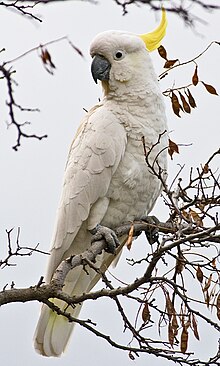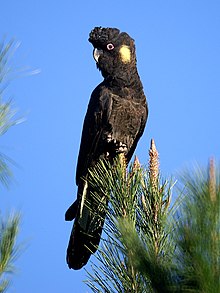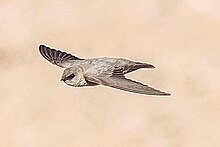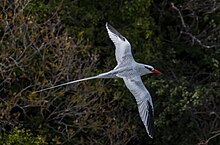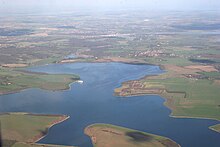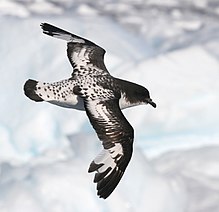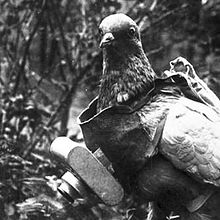Our website is made possible by displaying online advertisements to our visitors.
Please consider supporting us by disabling your ad blocker.
Portal:Birds
The Birds Portal

Birds are a group of warm-blooded vertebrates constituting the class Aves (Latin: [ˈaveːs]), characterised by feathers, toothless beaked jaws, the laying of hard-shelled eggs, a high metabolic rate, a four-chambered heart, and a strong yet lightweight skeleton. Birds live worldwide and range in size from the 5.5 cm (2.2 in) bee hummingbird to the 2.8 m (9 ft 2 in) common ostrich. There are over 11,000 living species and they are split into 44 orders. More than half are passerine or "perching" birds. Birds have wings whose development varies according to species; the only known groups without wings are the extinct moa and elephant birds. Wings, which are modified forelimbs, gave birds the ability to fly, although further evolution has led to the loss of flight in some birds, including ratites, penguins, and diverse endemic island species. The digestive and respiratory systems of birds are also uniquely adapted for flight. Some bird species of aquatic environments, particularly seabirds and some waterbirds, have further evolved for swimming. The study of birds is called ornithology.
Birds are feathered theropod dinosaurs and constitute the only known living dinosaurs. Likewise, birds are considered reptiles in the modern cladistic sense of the term, and their closest living relatives are the crocodilians. Birds are descendants of the primitive avialans (whose members include Archaeopteryx) which first appeared during the Late Jurassic. According to some estimates, modern birds (Neornithes) evolved in the Late Cretaceous or between the Early and Late Cretaceous (100 Ma) and diversified dramatically around the time of the Cretaceous–Paleogene extinction event 66 million years ago, which killed off the pterosaurs and all non-ornithuran dinosaurs.
Many social species preserve knowledge across generations (culture). Birds are social, communicating with visual signals, calls, and songs, and participating in such behaviour as cooperative breeding and hunting, flocking, and mobbing of predators. The vast majority of bird species are socially (but not necessarily sexually) monogamous, usually for one breeding season at a time, sometimes for years, and rarely for life. Other species have breeding systems that are polygynous (one male with many females) or, rarely, polyandrous (one female with many males). Birds produce offspring by laying eggs which are fertilised through sexual reproduction. They are usually laid in a nest and incubated by the parents. Most birds have an extended period of parental care after hatching.
Many species of birds are economically important as food for human consumption and raw material in manufacturing, with domesticated and undomesticated birds being important sources of eggs, meat, and feathers. Songbirds, parrots, and other species are popular as pets. Guano (bird excrement) is harvested for use as a fertiliser. Birds figure throughout human culture. About 120 to 130 species have become extinct due to human activity since the 17th century, and hundreds more before then. Human activity threatens about 1,200 bird species with extinction, though efforts are underway to protect them. Recreational birdwatching is an important part of the ecotourism industry. (Full article...)
Featured articles
Selected general bird topic
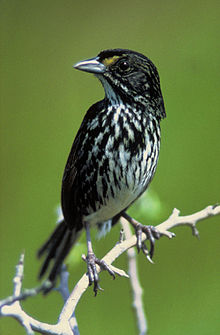
Bird conservation is a field in the science of conservation biology related to threatened birds. Humans have had a profound effect on many bird species. Over one hundred species have gone extinct in historical times, although the most dramatic human-caused extinctions occurred in the Pacific Ocean as humans colonised the islands of Melanesia, Polynesia and Micronesia, during which an estimated 750–1,800 species of birds became extinct. According to Worldwatch Institute, many bird populations are currently declining worldwide, with 1,200 species facing extinction in the next century. The biggest cited reason surrounds habitat loss. Other threats include overhunting, accidental mortality due to structural collisions, long-line fishing bycatch, pollution, competition and predation by pet cats, oil spills and pesticide use and climate change. Governments, along with numerous conservation charities, work to protect birds in various ways, including legislation, preserving and restoring bird habitat, and establishing captive populations for reintroductions.
See Late Quaternary prehistoric birds for birds which disappeared in prehistoric and early historic times, usually due to human activity (i.e., starting with the Upper Paleolithic Revolution). For birds having gone extinct in modern times (since 1500), see List of extinct birds. (Full article...)
Selected taxon
The order Falconiformes (/fælˈkɒnɪˌfɔːrmiːz/) is represented by the extant family Falconidae (falcons and caracaras) and a handful of enigmatic Paleogene species. Traditionally, the other bird of prey families Cathartidae (New World vultures and condors), Sagittariidae (secretarybird), Pandionidae (ospreys), Accipitridae (hawks) were classified in Falconiformes. A variety of comparative genome analyses published since 2008, however, found that falcons are part of a clade of birds called Australaves, which also includes seriemas, parrots and passerines. Within Australaves falcons are more closely related to the parrot-passerine clade than they are to the seriemas. The hawks, vultures and owls are placed in the clade Afroaves.
The cladogram of the Telluraves shown below is based on the study by Josefin Stiller and collaborators published in 2024. The species numbers are taken from the December 2023 version of the list maintained by Frank Gill, Pamela C. Rasmussen and David Donsker on behalf of the International Ornithological Committee (IOC). This list includes the Cathartiformes (New World vultures) in the order Accipitriformes.
| Telluraves |
| ||||||||||||||||||||||||||||||||||||||||||||||||||||||||||||||||||||||||
The fossil record of Falconiformes sensu stricto is poorly documented. The only stem-falcons that have mostly complete remains are Masillaraptor parvunguis and Danielsraptor phorusrhacoides, while the other taxa Stintonornis mitchelli and Parvulivenator watteli are known from fragmentary remains. Mayr (2009) noted the similarity of Masillaraptor to the seriemas. One study from Wang et al. (2012) using 30 nuclear loci from 28 taxa found Falconidae and Cariamidae being sister taxa to each other. This has, however, not been supported by the latest major neoavian phylogenetic studies. A 2022 study recovers masillaraptorids as true falcons. (Full article...)
Topics
Anatomy: Anatomy • Skeleton • Flight • Eggs • Feathers • Plumage
Evolution and extinction: Evolution • Archaeopteryx • Hybridisation • Late Quaternary prehistoric birds • Fossils • Taxonomy • Extinction
Behaviour: Singing • Intelligence • Migration • Reproduction • Nesting • Incubation • Brood parasites
Bird orders: Struthioniformes • Tinamiformes • Anseriformes • Accipitriformes • Galliformes • Gaviiformes • Podicipediformes • Procellariiformes • Sphenisciformes • Pelecaniformes • Ciconiiformes • Phoenicopteriformes • Falconiformes • Gruiformes • Charadriiformes • Pteroclidiformes • Columbiformes • Psittaciformes • Cuculiformes • Strigiformes • Caprimulgiformes • Apodiformes • Coraciiformes • Piciformes • Trogoniformes • Coliiformes • Passeriformes
Bird lists: Families and orders • Lists by region
Birds and humans: Ringing • Ornithology • Bird collections • Birdwatching • Birdfeeding • Conservation • Aviculture
Quotes
| “ | The bird of paradise alights only upon the hand that does not grasp. | ” |
Resources
Free online resources:
- SORA: The Searchable Online Research Archive (SORA) has decades worth of archives of the following journals: The Auk, The Condor, Journal of Field Ornithology, North American Bird Bander, Studies in Avian Biology, Pacific Coast Avifauna, and The Wilson Bulletin. Coverage ends around 2000. The ability to search all journals or browse exists on the front page.
- Notornis: The Journal of the Ornithological Society of New Zealand covers New Zealand and the South Pacific.
- New Zealand Journal of Ecology: This journal often publishes bird-related articles. Like Notornis, this journal is concerned with New Zealand and surrounding areas.
- Marine Ornithology: Published by the numerous seabird research groups, Marine Ornithology is specific and goes back many years.
- BirdLife International: The Data Zone has species accounts for every species, although threatened species and some key groups have greater detail with others only having status and evaluation.
- Author Index: This is a good source for binomial authorities for taxoboxes.
There is also Birds of North America, Cornell University's massive project collecting information on every breeding bird in the ABA area. It is available for US$40 a year.
For more sources, including printed sources, see WikiProject Birds.
WikiProjects
Selected images
Selected bird anatomy topic

The eye-ring of a bird is a ring of tiny feathers that surrounds the orbital ring, a ring of bare skin immediately surrounding a bird's eye. The eye-ring is often decorative, and its colour may contrast with adjoining plumage. The ring of feathers is sometimes incomplete, forming an eye arc. In the absence of a conspicuous eye-ring, the orbital ring of a bird is often referred to as the eye-ring. The bare orbital ring may be hardened or fleshy, or may form an eye-wattle. These are useful field marks in many bird species, and the eye-ringed flatbill, eye-ringed tody-tyrant and eye-ringed thistletail are examples of species named for either of these. (Full article...)
Selected species
Did you know
- ...that sexual size dimorphism in the brown songlark is among the most pronounced in any bird, with males as much as 2.3 times heavier than females?
- ...that rufous whistler birds, unlike all other whistler birds, never forage on the ground but high up in trees or other high places?
- ...that the bill of the magpie duck (pictured) becomes green as the bird gets older, and its black crown may go completely white?
Categories
Related portals
Things you can do
Create requested articles (WikiProject Birds – Article requests):
Do these tasks:
 |
Here are some tasks awaiting attention:
|
More outstanding tasks at the project's cleanup listing, Category:Birds articles needing attention, and Wikipedia:WikiProject Birds/Todo.
Taxonomy of Aves
| Class Aves, divided into superorders, orders, suborders (where indicated), and families. | ||||
|---|---|---|---|---|
|
Associated Wikimedia
The following Wikimedia Foundation sister projects provide more on this subject:
-
Commons
Free media repository -
Wikibooks
Free textbooks and manuals -
Wikidata
Free knowledge base -
Wikinews
Free-content news -
Wikiquote
Collection of quotations -
Wikisource
Free-content library -
Wikispecies
Directory of species -
Wikiversity
Free learning tools -
Wikivoyage
Free travel guide -
Wiktionary
Dictionary and thesaurus
Sources
- ^ Progressive Farmer. Progressive Farmer Company. 1997. p. 64. Retrieved February 7, 2020.
Previous Page Next Page


